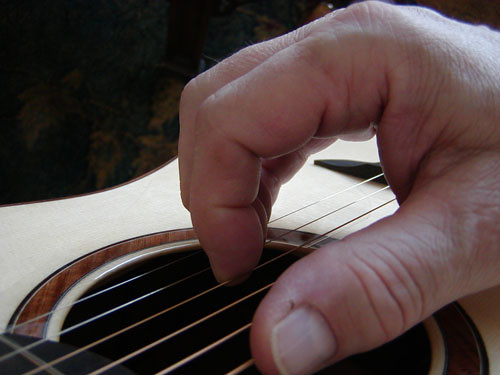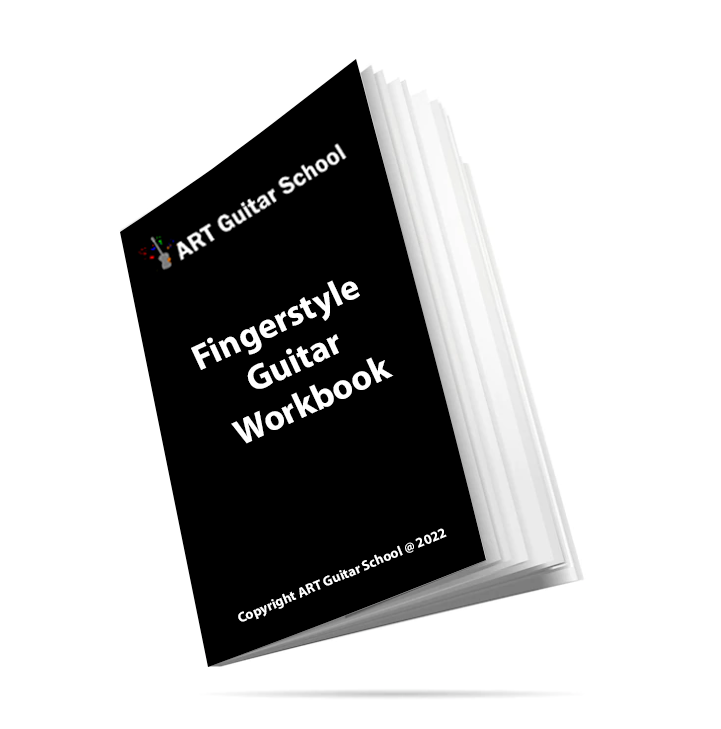One of the most common questions that arise when discussing fingerstyle is if you should use nails or flesh when playing.
Nails require you to either grow out your fingernail or apply acrylics whereas flesh doesn’t require any additional maintenance except for cutting the nails.
You may be asking, what are the main differences and advantages/disadvantages between the two?
Nails
Right off the bat, nails are going to provide a brighter tone due to the material that is striking through the string. With proper shaping and filing technique the nails could provide a warmer tone. This requires several adjustments with the filing of the nail in order for the nail to come out just right for your specific right hand technique. There are many different angles & approaches but all have the same principle.
This picture demonstrates a good nail length and shaping to start with:
Flesh
This route is the most common to start with, as it doesn’t require any additional work in order to play fingerpicking guitar. If we forget the nails and disregard any artificial product we use our flesh to fingerpick. The flesh provides a much warmer tone and less volume as well as dynamic range since it’s not likely to project as well as nails.

Here is a video on nail shaping I recommend:
Deciding on your nails or flesh is based on your personal taste and the sound that you’re trying to achieve. If you were a fingerstyle player or classical guitar player it is recommended that you at least try the nails and see if they’re a good fit for you. If you have brittle nails, there are hardening products and vitamins that can help to be able to strengthen them.
Learn more about technique through our FREE Fingerstyle Workbook!
FOLLOW US ON
Get our FREE Fingerstyle Workbook!
RELATED BLOG POSTS
Exploring Alternate Tunings for Fingerstyle Guitar
Alternate tunings open up a whole new world of possibilities for fingerstyle guitar players. In this post, we’ll explore popular alternate tunings and how they can enhance your fingerstyle playing.
What is Alternate Tuning? Alternate tuning refers to tuning the guitar strings to a different pitch than standard tuning (EADGBE). This allows you to create more resonant chords and access unique sounds.
Popular Fingerstyle Tunings
Drop D Tuning (DADGBE): Popular in rock and folk music, Drop D tuning allows for easy power chords and a deeper, fuller sound.
Open G Tuning (DGDGBD): Great for blues and folk styles, this tuning lets you play a G major chord with all strings open.
DADGAD Tuning: Often used in Celtic music, DADGAD creates rich, harmonic sounds ideal for fingerstyle arrangements.
How to Use Alternate Tunings Experiment with these tunings to discover new chord shapes, riffs, and melodic patterns. Each tuning can inspire unique compositions and variations in your playing.
Mastering Travis Picking: The Heart of Fingerstyle Guitar
Travis Picking is one of the most important techniques in fingerstyle guitar, especially for beginners. In this post, we will guide you through mastering Travis picking, a staple in folk, country, and blues guitar styles.
What is Travis Picking? Travis picking involves alternating your thumb between bass notes on the low strings while your fingers play the melody on the higher strings. This technique creates a smooth, rolling feel that’s characteristic of classic fingerstyle playing.
How to Start Start by practicing with simple patterns. For example:
Thumb (P) – 6th string (E)
Index (I) – 3rd string (G)
Thumb (P) – 4th string (D)
Middle (M) – 2nd string (B)
Gradual Speed Increase Start slow to ensure accuracy and consistency. Use a metronome to increase your speed gradually, and remember, the goal is to maintain clean, precise picking and rhythm.
Fingerstyle Guitar Exercises: Build Strength and Dexterity
If you want to master fingerstyle guitar, consistent practice is essential. In this post, we provide structured exercises to help you build finger strength, dexterity, and coordination.
Thumb Independence Exercises Start by practicing thumb-only exercises to develop independence between your thumb and fingers. Play simple bass lines while focusing on maintaining a steady rhythm.
Finger Coordination To improve your finger coordination, practice alternating between your thumb and fingers, playing simple patterns and focusing on smooth, fluid movement.
Speed and Accuracy Start slow, and gradually increase your speed while maintaining accuracy. Use a metronome to help develop timing and precision as you work through your exercises.





0 Comments